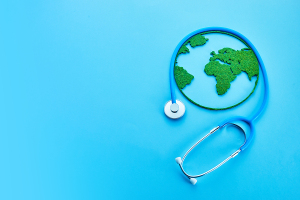by
Gus Iversen, Editor in Chief | April 19, 2023
The healthcare system is a substantial contributor to greenhouse gas emissions, and radiology’s role in it presents an opportunity to lead low-carbon, sustainable initiatives in workplaces and communities, according to a special report published in Radiology, a journal of the RSNA.
The special report addresses the importance of climate change to radiologists and the medical imaging community, including the impact on human health and health equity, the contribution of healthcare and medical imaging to the climate crisis, and the impetus to build a more sustainable future.
“The focus is on actions and opportunities to address climate change in our role as radiologists and to link our actions with their impact and expected outcome,” said the report’s senior author Dr. Kate Hanneman, associate professor in the Department of Medical Imaging at the University of Toronto and sustainability lead at University Medical Imaging Toronto in Toronto, Canada. “Because radiologists are adept at managing rapid technological change, we are ideally positioned to lead these initiatives within our departments, healthcare systems and communities.”



Ad Statistics
Times Displayed: 45526
Times Visited: 1299 Ampronix, a Top Master Distributor for Sony Medical, provides Sales, Service & Exchanges for Sony Surgical Displays, Printers, & More. Rely on Us for Expert Support Tailored to Your Needs. Email info@ampronix.com or Call 949-273-8000 for Premier Pricing.
Due to its large size and its intensive use of resources, the global healthcare system emits more than 2 gigatons of CO2 equivalent annually and accounts for 5 to 8.5% of total greenhouse gas emissions in developed nations.
While the majority of greenhouse gases emitted by the healthcare sector come from manufacturing, transporting, using and disposing of purchased goods, the sources of emissions from individual specialties differ. For diagnostic radiology, most emissions come from the production of medical imaging equipment and the energy needed to power it. Overall, medical imaging is estimated to account for 1% of global greenhouse gas emissions.
“The harmful health effects of climate change disproportionately impact those already vulnerable due to social, environmental, and public health factors,” Dr. Hanneman said. “Groups most likely to be harmed are those already experiencing health inequities due to age, race, culture, sex/gender, socioeconomic status, geographic location and chronic illness.”
The report outlines a framework for environmentally sustainable health systems that can be applied in radiology departments. First, reduce demand for healthcare services by supporting policies and programs that promote public health, including screening. Second, match the supply of health services to the demand; for example, by ensuring the appropriate use of imaging. Finally, reduce emissions from the provision of necessary care.
Back to HCB News

